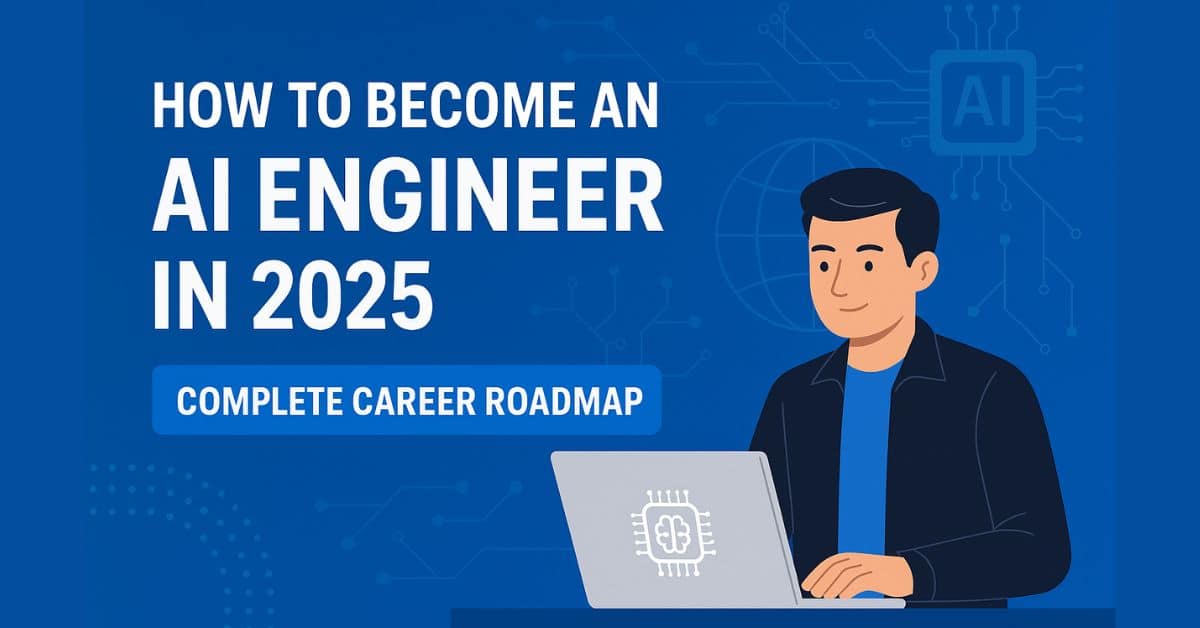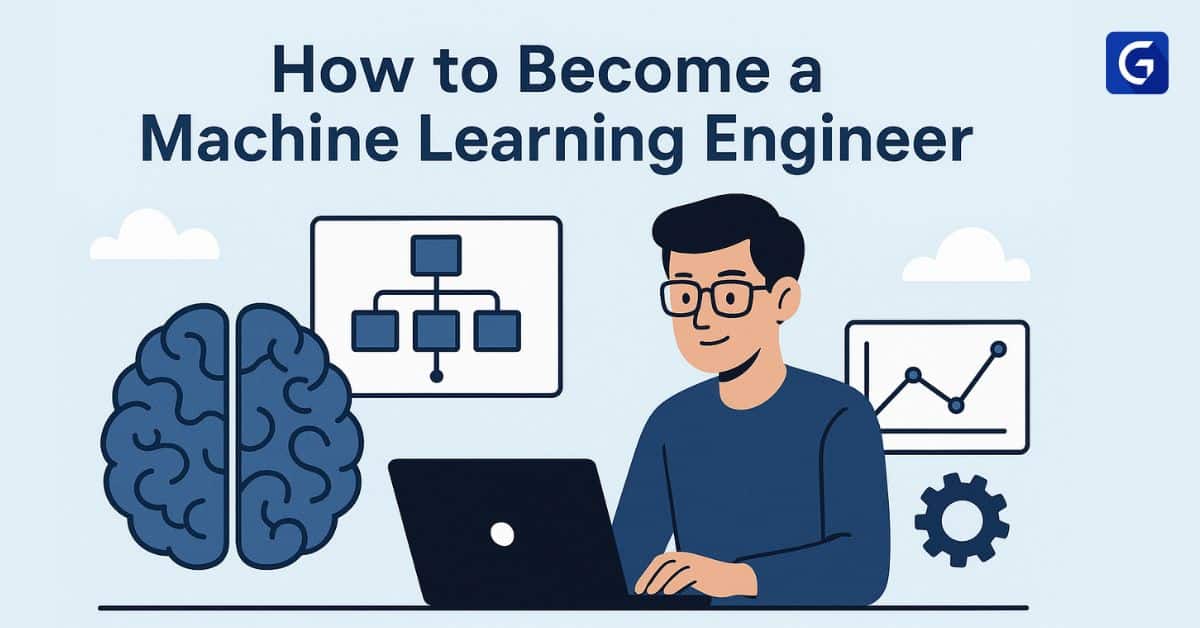The demand for AI talent is rapidly increasing, making artificial intelligence job positions extremely difficult to obtain.
Organizations in healthcare and finance and entertainment and logistics sectors leverage AI technology to solve complex problems as they gain competitive dominance across different business sectors.
Success in the field of AI demands professionals to prove expertise in theoretical concepts together with practical ability because industry rapidly implements AI technology.
Experts moving up in Artificial Intelligence careers need to practice interview responses focused on target positions.
The skill enables you to explain concepts clearly while resolving issues efficiently and present your relevant work experience. Your strategic preparation will enhance your chances of securing desirable positions within this expanding and exciting field of work.
AI interview preparation becomes challenging because interview questions span a wide range of topics that include basic AI principles and intricate algorithms and practical applications.
A. AI Interview Questions and Answers For Freshers (Beginner Level)

1. What is Artificial Intelligence (AI)?
Artificial Intelligence is an area within computer science that develops intelligent machines to perform tasks traditionally handled by human intelligence. The capabilities of artificial intelligence include learning and reasoning as well as problem-solving, perception and language understanding, among others.
The primary goal of AI is to develop mathematical procedures that replicate human-like cognitive operations through data-driven processing methods.
2. What are the common misconceptions about AI?
Various people consider machine learning to be synonymous with artificial intelligence, believing that computers can perform self-learning without needing data input.
AI raises alarm among some people who fear that machines will ultimately eliminate human existence entirely. The objective function of AI systems depends on human assistance while utilizing instructed teaching methods alongside data inputs.
Suggested: AI Advantages and Disadvantages
3. What are some real-life applications of AI?
Modern technology employs AI in three main applications: facial recognition features of social media platforms with recommendation engines for shopping commerce, alongside driverless vehicles and diagnostic systems for medicine and agricultural asset tracking tools.
These applications assist with automated processes and deliver intelligent support services for making decisions.
4. What are the types of AI?
Within the overall AI category, three divisions exist: task-specific Narrow AI, self-aware Super AI, and human-equivalent General AI.
AI can be classified into two distinct categories based on its capabilities, as well as whether it demonstrates reactive behavior, limited memory, a theory of mind, or self-awareness.
5. What is the difference between AI, Machine Learning (ML), and Deep Learning (DL)?
AI stands as the science that focuses on intelligent behaviors as its primary goal. The field of machine learning (ML) operates as a subcategory of artificial intelligence (AI) by enabling machines to automatically acquire knowledge from data.
A neural network structure called Deep Learning (DL) processes elaborate data patterns as a specialized subset within the field of machine learning.
6. What are the different types of Machine Learning?
There are three main types: Supervised learning (uses labeled data), Unsupervised learning (finds hidden patterns in unlabeled data), and Reinforcement learning (agents learn by interacting with an environment and receiving feedback).
7. What programming languages are used in AI?
The simplest and most extensive libraries in Python make this language the most widely chosen among programmers.
Among the languages used in AI development are R for statistical processing, Java for production tasks, and C++ for performance enhancements, while LISP serves as a historical landmark in AI research.
Read: Top 7 AI Programming Languages
8. What platforms are used for AI development?
Development platforms for AI include TensorFlow, PyTorch, IBM Watson, Microsoft Azure AI, Google AI tools, as well as Amazon AI services. Data scientists can utilize these platforms for the efficient creation of intelligent applications, which include both pre-developed models and expandable development spaces.
9. What is Deep Learning?
ML includes Deep Learning as its subset, which utilizes artificial neural networks with hidden layers to duplicate human brain functionalities.
This technology demonstrates outstanding capability in processing large data collections and successfully carries out visual recognition, along with natural language interpretation.
Also Read: Top Applications of Deep Learning Across Industries
10. What is Natural Language Processing (NLP)?
NLP stands as a fundamental AI subdivision that enables machines to study, understand and generate human speech. Chatbots, along with translation applications, combine with speech recognition and tools that perform sentiment analysis under the same umbrella of NLP.
11. What is the difference between NLP and Text Mining?
NLP enables machines to develop comprehension and generation capabilities for human-based language at a meaningful level. NLP analyzes text structures together with its semantic content. Text mining involves extracting valuable insights from large datasets comprising textual information.
The identification of hidden trends in data is achieved through the combination of statistical methods and pattern recognition techniques. Language comprehension depends on NLP technology, which text mining systems utilize for analytical operations.
12. What is Fuzzy Logic?
Fuzzy Logic functions as a multi-focused mathematical system that processes unclear reasoning instead of static, precise decisions.
Fuzzy logic differs from standard binary systems because it enables continuous truth value ranges from zero to one. This approach excels at addressing practical problems that require working with unclear or imprecise data.
This technology is used in air conditioners, automatic gearboxes, and washing machines. Fuzzy logic emulates human decision-making processes by improving uncertain situations through its reasoning approach.
13. What is an expert system?
An expert system enables the emulation of human experts’ performance within a specified domain area. A well-designed system employs rules and facts, combined with an inference engine, which allows it to perform simulated reasoning.
Such systems perform tasks involving complicated matters such as medical condition diagnosis and machine fault detection. The systems provide solutions at an expert level while working independently from human operators. The technology has applications in patient diagnosis, legal assistance, and automated customer support operations.
14. What are the components of an expert system?
The essential parts of an expert system include three main elements:
- Domain-specific reality and control knowledge reside within the system as a Knowledge Base component.
- An inference engine uses logical approaches to generate solutions or draw final conclusions from the stored information.
- User Interface: Facilitates communication between the system and end-user.
This combination of system components enables the system to draw informed conclusions by replicating expert decision-making capabilities.
15. What is the future of AI?
AI will push innovative developments through multiple business domains, including healthcare, transportation, finance, and education. Through the implementation of AI, we will make better decisions supported by the automation of repetitive work, while increasing overall efficiency.
Modern artificial intelligence systems can advance the prediction of climate change, discover new drugs, and create customized educational plans. Further growth in AI systems will require a greater focus on ethical issues and the avoidance of discrimination, alongside maintaining system transparency.
Humanity should develop AI systems that operate under responsible control and show their decision-making methods with accountability to human operators.
16. What are some examples of AI in daily life?
People encounter AI through multiple everyday tools, including voice assistants such as Siri and Alexa. Recommendation systems found on platforms like Netflix, Amazon, and YouTube operate using this technology.
The email spam filtering, as well as the messaging application’s automatic correction, uses artificial intelligence systems. Cell phone camera image scanning functions and tagging tools within social media platforms are illustrative implementations of this technology. Smart thermostats, along with fitness trackers, are electronic devices that rely on AI technology.
17. What is supervised learning?
A supervised learning framework utilizes machine learning models to gain knowledge from data collections that include labels. The relationship learning process within supervised learning occurs because correct output examples accompany the input data.
Supervised learning technology serves multiple functions, including detecting email spam, analyzing credit scores, and performing image recognition operations. As the model analyzes more examples, its performance accuracy tends to rise. Linear regression, together with decision trees and SVMs, represents the list of implemented algorithms.
18. What is unsupervised learning?
The training process of an unsupervised learning model operates with data that contains no output labels. The model undertakes an analysis of the data to find previously invisible organizational structures.
This method functions best for detecting clusters as well as market segmentation and identifying anomalies. Three algorithms under unsupervised learning are K-means clustering, hierarchical clustering, and Principal Component Analysis (PCA). Using this approach is beneficial when labeled data is unavailable or too expensive to acquire.
Also read: Supervised vs Unsupervised Learning: What is the Difference?
19. What is reinforcement learning?
As part of reinforcement learning, an agent undertakes actions in an environment to collect the highest possible total rewards. The feedback given to the agent comes through rewards and penalties.
The agent develops optimal strategies by conducting repeated attempts to discover effective methods. The technology serves robotics and autonomous vehicles in addition to allowing AlphaGo to play games autonomously. Reinforcement learning is comprised of three essential components: states, actions, and reward functions.
20. What is the Turing Test?
The Turing Test, created by Alan Turing, enables the assessment of machine intelligence by evaluating its performance in convincing human judges that it exhibits human-like responses. A judge who conducts the evaluation process interacts directly with both a machine and a person.
The AI system passes the test when the judge is unable to distinguish between a human and a machine unit. Conversational AI uses this measurement to determine its capabilities. The test generated discussions about machines potentially acquiring consciousness, but failed to deliver final answers.
21. What is the difference between AI and robotics?
AI experts strive to develop computers that replicate human intelligence capabilities across problem-solving, learning, and reasoning processes. Robotics manages the creation of physical devices, while robotics functions to control physical systems.
Robots gain intelligence through embedded AI systems, which perform both navigation and vocal communication abilities. The employment of AI does not necessarily require robots, just as robots do not always need AI for their operation. Through union, they create intelligent machines that possess sensing and acting abilities.
B. For Experienced Candidates (Intermediate to Advanced)
22. What is overfitting, and how can it be avoided?
A model suffers from overfitting when it learns the training data in excessive detail, which contains noise, resulting in poor performance on new data. An overspecified model indicates that the current data cannot support such a level of complexity.
Techniques such as regularization, along with pruning, cross-validation, and early stopping, help prevent this issue. More training data accompanies model simplification as an effective measure to improve performance. The essential practice for maintaining model validity involves observing performance metrics on validation datasets.
23. What are hyperparameters in machine learning?
Hyperparameters are the settings configured before model training begins. Users define how learning takes place, as well as the number of hidden layers and epochs, together with the batch size when configuring models. The training process does not adjust these variables because they remain outside the parameters that are learned during training.
The quality of model performance depends heavily on selecting appropriate hyperparameters at the beginning of the process. The combination of grid search and random search represents methods to adjust these parameters.
24. Explain the difference between parametric and non-parametric models.
Parametric models maintain constant parameters on which they rely, regardless of the dataset’s size. Linear regression and logistic regression represent examples among parametric models. Non-parametric models use few assumptions and develop progressively complex structures when provided with additional data.
Among popular choices are k-Nearest Neighbors (KNN) and decision trees. Parametric models execute quickly but lack flexibility while non-parametric models bring better adaptability to analysis.
25. What are activation functions? Name some.
Through activation functions, neural networks obtain the ability to discover intricate patterns while accepting nonlinear values. The activation function determines whether the nerve cell will activate or remain inactive.
Three widely used activation functions are the Sigmoid function, combined with the Rectified Linear Unit (ReLU), and the Tanh function. ReLU maintains its popularity in the industry because it achieves high performance while being straightforward to implement. Learning speed, together with performance results, is directly influenced by the selected activation function.
26. What is a neural network?
The computational model that mimics the brain’s neural structure stands as a neural network. The neural network comprises multiple layers of node elements, each utilizing weights to establish its network connectivity.
The system takes input data through its hidden layers to generate an output result. Neural networks operate to identify images, process speech, and perform natural language tasks. Such networks incorporate multiple hidden layers to achieve their complex learning objectives.
27. What is the bias-variance tradeoff?
A fundamental relationship exists between bias and variance in statistical predictive models, affecting their performance. A model with excessive simplicity underfits the data when its bias is too high. High model variance indicates that the system is too intricate while attempting to fit the data.
The objective aims to establish error reduction through optimal model adjustments. Cross-validation with regularization allows users to strike an optimal balance between these competing factors.
Also read: What is Cross Validation in Machine learning? Types of Cross Validation
28. What is transfer learning?
Transfer learning enables the use of existing model training results from one task to initiate similar model work on related tasks. Knowledge sharing through this approach enables domain sharing, which saves time and reduces costs.
This approach delivers maximum value because new task labeling data remains sparse. The pre-training of BERT, ResNet, and GPT is a common approach in transfer learning methods. The method enhances performance levels within environments where data quantities remain low.
29. How do you evaluate a classification model?
Classification models receive evaluation metrics that include accuracy, precision, recall, and the F1-score. The evaluation of model accuracy demonstrates complete correctness; however, precision and recall specifically measure how well the model handles actual positive outcomes, as well as false negative situations.
The F1-score balances precision and recall. The performance evaluation of machine learning models at various thresholds is performed using ROC-AUC calculation. The assessment of model performance is done through confusion matrices.
30. What is the difference between batch and online learning?
Training the model through batch learning occurs with the entire dataset available. An approach suitable for dealing with static motivational data that becomes available before a program begins.
The model receives incremental updates by processing new data that arrives. Such systems prove effective for immediate applications where the detection of fraud or the provision of news recommendations needs to happen quickly. The speed of adaptation is strong with online models, yet their precision requires more attention.
31. What is the role of the inference engine in expert systems?
The inference engine operates on the knowledge base by applying logical rules to produce decisions or draw conclusions. The tool applies IF-THEN rules to virtual human expert expertise, displaying simulated human expert logical processing.
This system operates using either forward chaining or backward chaining methods, depending on the specified problem. The quality level of inference directly stems from an expert system’s collection of knowledge. It is necessary to consider this component because it serves as the reasoning component for expert systems.
32. Explain the concept of Markov Decision Process (MDP).
A Markov Decision Process serves as a model for making decisions when randomness influences the outcomes. An MDP combines states, actions, and transition probabilities, as well as rewards.
The agent follows a policy to select its actions, aiming for the maximum expected reward.
The application of Markov Decision Processes extends throughout most reinforcement learning operations. These techniques enable the modeling of situations that contain uncertain conditions as well as late feedback responses.
33. What are convolutional neural networks (CNN)?
CNNs constitute a special type of neural network that excels at recognizing images and videos. Los Angeles patterns, through convolutional layers, detect fundamental characteristics of edges in image regions and image texture details.
Fully connected layers perform predictions, yet pooling layers decrease the number of dimensions during processing. Visual recognition tasks perform remarkably well with the aid of convolutional neural networks. They duplicate the operational methods of the human visual cortex in their design.
34. What is the difference between AI, ML, and DL from a technical perspective?
The broad science of AI serves to make machines intelligent and behaviorally thoughtful through this method. ML operates as a specific field of AI dedicated to extracting predictions from data analysis.
High-dimensional data requires deep neural networks for successful processing, according to the principles of deep learning (DL), which is a specialized sector of machine learning (ML). The systems employing logical rules are part of AI, but the main emphasis of DL remains pattern extraction. DL requires additional complexity and requires large amounts of data for its operation.
35. How is AI used in fraud detection?
Transaction patterns are analyzed by AI systems, which identify exceptions to normal behavior through the software. Through classification models, it identifies patterns that are normal and distinguishes them from fraudulent activities.
Unsupervised learning methods help organizations identify new types of fraudulent activities. AI platforms maintain the ability to recognize and modify their recognition of fraudulent schemes throughout their operation. The system enhances both the precision rate and the efficiency of detecting doubtful transactions.
Also read: How Machine Learning is Changing Identity Theft Detection
36. What is a confusion matrix?
The performance evaluation of classification models is conducted through a confusion matrix, which is set up as a graphical table. The table includes separate sections to display both positive and negative categories, which are real or incorrect.
The metrics of accuracy, precision, and recall enable calculation through this method. The matrix presents information about the errors the model identifies. Model performance evaluation requires the confusion matrix as an essential tool for gaining complete details about behavior.
37. What is dimensionality reduction?
The process of dimensionality reduction seeks to decrease the number of input variables contained within data sets. The practice of dimensionality reduction serves three purposes: it simplifies models, accelerates training processes, and facilitates visual representation.
The data analysis tools PCA (Principal Component Analysis) and t-SNE represent standard techniques in practice. This tool proves suitable for operationalizing image and text datasets that contain many dimensions. The primary objective is to maintain essential elements and eliminate unnecessary background data.
38. Explain the difference between generative and discriminative models.
Generative models discover both the probability distribution between features and their respective labels (P(x, y)) while featuring the ability to generate new data samples. The Naive Bayes, along with GANs, represent two models among examples.
The task assignment between classes functions as a core component that discriminative models learn to identify (P(y|x)). Two examples from this group are logistic regression and support vector machines (SVMs). The models that generate new samples offer higher flexibility, but discriminative models tend to produce more accurate results.
39. What is reinforcement learning’s exploration vs. exploitation dilemma?
This dilemma is about balancing two strategies:
- Exploration: Trying new actions to discover better rewards.
- Exploitation: Using known actions that yield high rewards
Choosing one over the other too much can reduce performance. Algorithms use strategies like ε-greedy to maintain balance.
40. What are some challenges in AI implementation?
The implementation of artificial intelligence faces multiple challenges, stemming from substandard data quality and datasets containing systematic biases, as well as the need for explanation capabilities and substantial computing expenses.
The process of integrating new systems with existing infrastructure proves to be challenging. They raise additional ethical concerns regarding privacy protection, as well as ensuring fair practices and maintaining accountability.
The adoption process may face difficulties because there are insufficient qualified experts available. For the successful implementation of AI, three areas require a perfect fit: technology, ethical principles, and organizational systems.
41. How do you optimize content creation using AI?
Tools based on GPT technology serve as AI platforms which smooth content generation processes. NLP technology enables users to handle both text compression as well as document translation while obtaining important data points.
AI sentiment analysis tools help businesses determine appropriate language approaches toward their consumers. Recommendation systems personalize content delivery. Through automation AI both cuts down human work requirements and enhances marketing content production rate while increasing audience commitment.
Also read: 10 Effective Approaches for Content Optimization with AI
Key Skills and Qualities for AI Professionals
A job candidate requires these competencies to demonstrate their technical excellence and solution communication skills during interviews and to deliver practical results through technical execution and collaborative problem-solving after getting hired.

Technical Skills
- The basic requirement for AI technical achievement demands expertise in programming languages, including Python and R, as these languages form the foundational elements for most AI development processes, alongside data analytical functions.
For those looking to build a strong foundation, a Python Programming course can be a valuable starting point.
- Linear algebra alongside calculus is a must to understand probability and statistics, which lays the groundwork for creating and interpreting AI models successfully.
- Professionals need to master machine learning and deep learning algorithm implementation while having knowledge of TensorFlow and PyTorch frameworks and demonstrating high competence in dataset management.
- Professionals who master data modeling seek and obtain valuable information from complex datasets by managing engineering operations and analysis functions. These foundational skills set the base for building functional AI systems.
Soft Skills
Equally important are soft skills.
- Success in professional complex problem-solving arises when analytical thinking unites with innovative solution delivery.
- The ability to stay relevant depends on professional adaptability, as innovative thinking generates new algorithms and application procedures.
- Professional success in diverse teams that include non-IT functions demands both exceptional communication capabilities and superior teamwork skills for the transmission of technical details to stakeholders without technical expertise.
- Volume and speed in industry require ongoing professional learning because new tools and methodologies often emerge in this field.
Additional Resources and Next Steps
Learners can find valuable training through Google AI Essentials alongside free training materials on Great Learning’s AI Free Courses..
Download the latest information from the Towards Data Science blog while reading “Artificial Intelligence: A Modern Approach” through books.
The platform“InterviewsBit” and mock interviews help candidates develop their interview skills for better preparation.
Continuous learning is the essential practice for success in industries as AI continues to transform their operations. Stay curious, keep honing your skills, and approach every interview as a valuable learning experience. Good luck on your journey to becoming an AI professional- your next big opportunity could be just around the corner!









